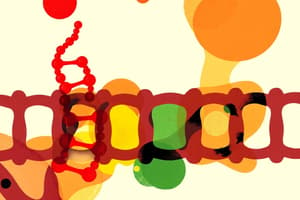Podcast
Questions and Answers
Which of these options are correct? (Select all that apply) Biotechnology, as you would have learnt from the previous chapter, essentially deals with industrial scale production of biopharmaceuticals and biologicals using genetically modified microbes, fungi, plants and animals. The applications of biotechnology include:
Which of these options are correct? (Select all that apply) Biotechnology, as you would have learnt from the previous chapter, essentially deals with industrial scale production of biopharmaceuticals and biologicals using genetically modified microbes, fungi, plants and animals. The applications of biotechnology include:
- Genetically modified crops for agriculture (correct)
- Waste treatment (correct)
- Therapeutics (correct)
- Energy production (correct)
- Diagnostics (correct)
- Bioremediation (correct)
- Processed food (correct)
What are the three critical research areas of Biotechnology?
What are the three critical research areas of Biotechnology?
Providing the best catalyst in the form of improved organism usually a microbe or pure enzyme. Creating optimal conditions through engineering for a catalyst to act, and Downstream processing technologies to purify the protein/organic compound.
Which of the following is NOT a major approach to increasing food production?
Which of the following is NOT a major approach to increasing food production?
- genetically modified animal-based agriculture (correct)
- organic agriculture
- genetically engineered crop-based agriculture
- agro-chemical based agriculture
The Green Revolution primarily focused on:
The Green Revolution primarily focused on:
Traditional breeding techniques were able to keep pace with the increasing demand for food and provided sufficiently fast and efficient systems for crop improvement.
Traditional breeding techniques were able to keep pace with the increasing demand for food and provided sufficiently fast and efficient systems for crop improvement.
What does tissue culture mean in the context of agriculture?
What does tissue culture mean in the context of agriculture?
What is micropropagation and why is it important?
What is micropropagation and why is it important?
Match the following agricultural practices with their descriptions:
Match the following agricultural practices with their descriptions:
Genetically modified organisms (GMOs) can be used to create crops that are more tolerant to abiotic stresses like cold, drought, salt, and heat.
Genetically modified organisms (GMOs) can be used to create crops that are more tolerant to abiotic stresses like cold, drought, salt, and heat.
Genetically modified organisms (GMOs) can help reduce the need for chemical pesticides, leading to a decrease in post-harvest losses.
Genetically modified organisms (GMOs) can help reduce the need for chemical pesticides, leading to a decrease in post-harvest losses.
Genetically modified organisms (GMOs) can increase the efficiency of mineral usage by plants and contribute to the enhancement of the nutritional value of food.
Genetically modified organisms (GMOs) can increase the efficiency of mineral usage by plants and contribute to the enhancement of the nutritional value of food.
Explain the mechanism of how Bt toxin works as a bio-pesticide in plants.
Explain the mechanism of how Bt toxin works as a bio-pesticide in plants.
What is the role of the cry genes in Bt cotton, and how do they protect the crop?
What is the role of the cry genes in Bt cotton, and how do they protect the crop?
What is RNA interference(RNAi) and how does it help in pest resistance?
What is RNA interference(RNAi) and how does it help in pest resistance?
What is the significance of the recombinant DNA technology in the field of healthcare?
What is the significance of the recombinant DNA technology in the field of healthcare?
Why is the use of genetically engineered insulin advantageous over extracting insulin from animal sources?
Why is the use of genetically engineered insulin advantageous over extracting insulin from animal sources?
What is gene therapy and how could it potentially address hereditary diseases?
What is gene therapy and how could it potentially address hereditary diseases?
The first clinical gene therapy was administered to a 4-year-old girl suffering from adenosine deaminase (ADA) deficiency.
The first clinical gene therapy was administered to a 4-year-old girl suffering from adenosine deaminase (ADA) deficiency.
Early diagnosis of diseases is essential for effective treatment and understanding the underlying pathophysiology.
Early diagnosis of diseases is essential for effective treatment and understanding the underlying pathophysiology.
Which of the following techniques are used for early diagnosis of diseases?
Which of the following techniques are used for early diagnosis of diseases?
How does Polymerase Chain Reaction (PCR) work?
How does Polymerase Chain Reaction (PCR) work?
What is ELISA and how is it used for disease diagnosis?
What is ELISA and how is it used for disease diagnosis?
What are transgenic animals and why are they important?
What are transgenic animals and why are they important?
What is the main reason for the increasing production of transgenic mice compared to other animals?
What is the main reason for the increasing production of transgenic mice compared to other animals?
Transgenic animals can be used for the study of:
Transgenic animals can be used for the study of:
Explain the concept of biopiracy.
Explain the concept of biopiracy.
The Indian Parliament has passed amendments to the Indian Patent Bill to address the concerns of biopiracy.
The Indian Parliament has passed amendments to the Indian Patent Bill to address the concerns of biopiracy.
Biotechnology has the potential to revolutionize agriculture by producing crops with increased yields, improved nutritional value, and enhanced resistance to various stresses.
Biotechnology has the potential to revolutionize agriculture by producing crops with increased yields, improved nutritional value, and enhanced resistance to various stresses.
Recombinant DNA technology has revolutionized healthcare by enabling the mass production of safe and effective therapeutic drugs, particularly for diseases that require human proteins.
Recombinant DNA technology has revolutionized healthcare by enabling the mass production of safe and effective therapeutic drugs, particularly for diseases that require human proteins.
Gene therapy offers a promising approach to treat genetic disorders by replacing or supplementing defective genes with functional counterparts.
Gene therapy offers a promising approach to treat genetic disorders by replacing or supplementing defective genes with functional counterparts.
Which of the following techniques are extensively used in early disease diagnosis?
Which of the following techniques are extensively used in early disease diagnosis?
Transgenic animals are created by introducing foreign genes into their genome, leading to a range of applications in research, medicine, and agriculture.
Transgenic animals are created by introducing foreign genes into their genome, leading to a range of applications in research, medicine, and agriculture.
Biopiracy involves the unauthorized use and exploitation of biological resources and traditional knowledge from developing countries without proper compensation or authorization.
Biopiracy involves the unauthorized use and exploitation of biological resources and traditional knowledge from developing countries without proper compensation or authorization.
The Indian government has taken steps to address the concerns of biopiracy by enacting legislation to protect its traditional knowledge and genetic resources.
The Indian government has taken steps to address the concerns of biopiracy by enacting legislation to protect its traditional knowledge and genetic resources.
Flashcards
Totipotency
Totipotency
The ability of a single cell to develop into a whole plant. This is a crucial aspect of tissue culture, allowing scientists to regenerate whole plants from small explants.
Micropropagation
Micropropagation
A method that enhances plant propagation by generating thousands of genetically identical plants from a single explant in a short period.
Somaclones
Somaclones
Genetically identical copies of plants produced through micropropagation.
Somatic Hybridisation
Somatic Hybridisation
Signup and view all the flashcards
Genetically Modified Organisms (GMOs)
Genetically Modified Organisms (GMOs)
Signup and view all the flashcards
Abiotic Stress Tolerant Crops
Abiotic Stress Tolerant Crops
Signup and view all the flashcards
Pest-Resistant Crops
Pest-Resistant Crops
Signup and view all the flashcards
Bt Toxin
Bt Toxin
Signup and view all the flashcards
Bt Crops
Bt Crops
Signup and view all the flashcards
RNA Interference (RNAi)
RNA Interference (RNAi)
Signup and view all the flashcards
Genetically Engineered Insulin
Genetically Engineered Insulin
Signup and view all the flashcards
Gene Therapy
Gene Therapy
Signup and view all the flashcards
Polymerase Chain Reaction (PCR)
Polymerase Chain Reaction (PCR)
Signup and view all the flashcards
Enzyme-Linked Immunosorbent Assay (ELISA)
Enzyme-Linked Immunosorbent Assay (ELISA)
Signup and view all the flashcards
Transgenic Animals
Transgenic Animals
Signup and view all the flashcards
Molecular Cloning
Molecular Cloning
Signup and view all the flashcards
Gene Expression
Gene Expression
Signup and view all the flashcards
Biopiracy
Biopiracy
Signup and view all the flashcards
Vaccine Safety Testing
Vaccine Safety Testing
Signup and view all the flashcards
Chemical Safety Testing (Toxicity Testing)
Chemical Safety Testing (Toxicity Testing)
Signup and view all the flashcards
Study Notes
Biotechnology Applications
- Biotechnology involves industrial-scale production of biopharmaceuticals and biologicals using genetically modified organisms (microbes, fungi, plants, and animals).
- Applications include therapeutics, diagnostics, genetically modified crops, processed food, bioremediation, waste treatment, and energy production.
- Key biotechnological research areas:
- Providing improved organisms (microbes or enzymes) as catalysts.
- Creating optimal conditions for catalysts to act efficiently.
- Developing downstream processing for purifying products (proteins/organic compounds).
Agricultural Applications
- Biotechnology aims to increase food production through three approaches:
- Agrochemical-based agriculture.
- Organic agriculture.
- Genetically engineered crops.
- The Green Revolution tripled food supply but wasn't enough to meet growing needs.
- Agrochemicals (fertilizers and pesticides) have been important for increasing yields but can be expensive and harmful.
- Traditional breeding techniques have limitations in keeping pace with demand, leading to the development of tissue culture.
- Tissue culture involves growing whole plants from plant parts (explants) in sterile nutrient media, leveraging the concept of totipotency.
- Micropropagation is a tissue culture technique to quickly produce numerous genetically identical plants (somatic clones).
- Important food plants like tomatoes, bananas, and apples are commercially produced through micropropagation.
- Scientists can recover healthy plants from diseased ones by culturing meristems (apical and axillary buds). These are free of viruses, enabling the production of healthy plants.
- Somatic hybridization involves fusing protoplasts (plant cells with their cell walls removed) from different plant varieties to create hybrid plants with desirable traits.
Medicinal Applications
- Recombinant DNA technology revolutionized healthcare by enabling the mass production of safe and effective therapeutic drugs.
- Recombinant therapeutics avoid unwanted immunological responses found in similar products from non-human sources
- Currently, about 30 recombinant therapeutics are approved for human use globally.
- In India, 12 recombinant therapeutics are currently marketed.
- Genetically engineered insulin enables diabetes management through regular insulin injections.
- Previously, insulin sources were extracted from slaughtered animals (cattle and pigs), potentially causing allergies or other reactions.
- Human insulin is now produced using recombinant bacteria, ensuring a safe and efficient source.
Transgenic Animals
- Transgenic animals have their DNA modified to express an extra gene, making them useful in various biotechnological applications.
- Studying normal animal physiology and development can shed light on gene regulation and the biological functions of certain genes.
- Transgenic animals can help study human diseases, create models for testing treatments, and enhance our understanding of how genes contribute to diseases like cancer, cystic fibrosis, etc.
Ethical Issues
- Ethical considerations are crucial in using biotechnology, as the manipulation of living organisms may have unpredictable consequences in ecosystems.
- Government organizations (like India's GEAC-Genetic Engineering Approval Committee) regulate genetically modified (GM) research and the introduction of GM-organisms into the ecosystem.
- Ethical considerations also arise from the grant of patents for biological resources, as indigenous knowledge and traditional practices should be recognized and valued.
Summary of Biotechnology
- Biotechnology has significant applications in agriculture, medicine, and the production of valuable biological products.
- Transgenic organisms can be used in numerous ways but also raise ethical concerns.
Studying That Suits You
Use AI to generate personalized quizzes and flashcards to suit your learning preferences.





